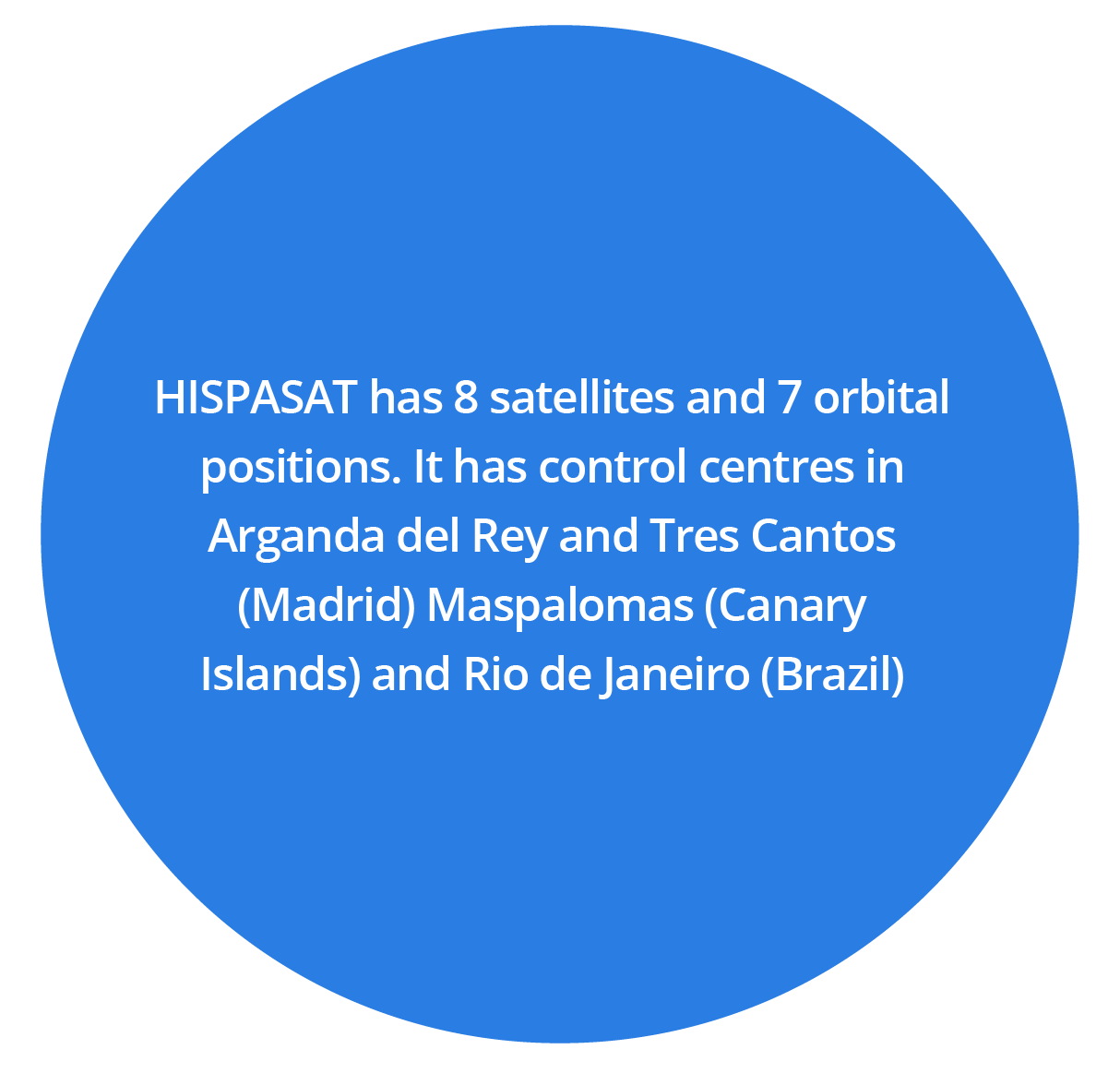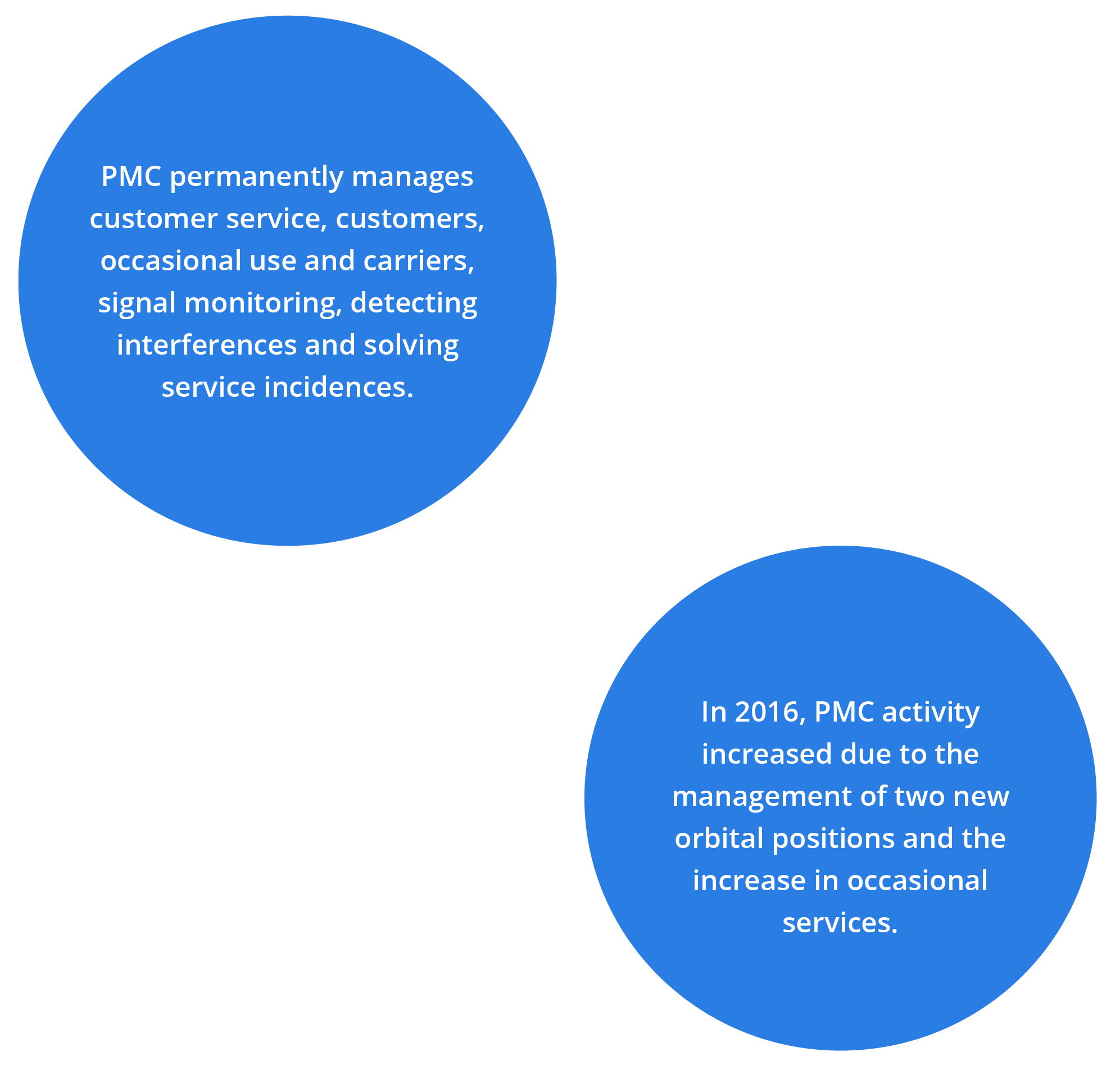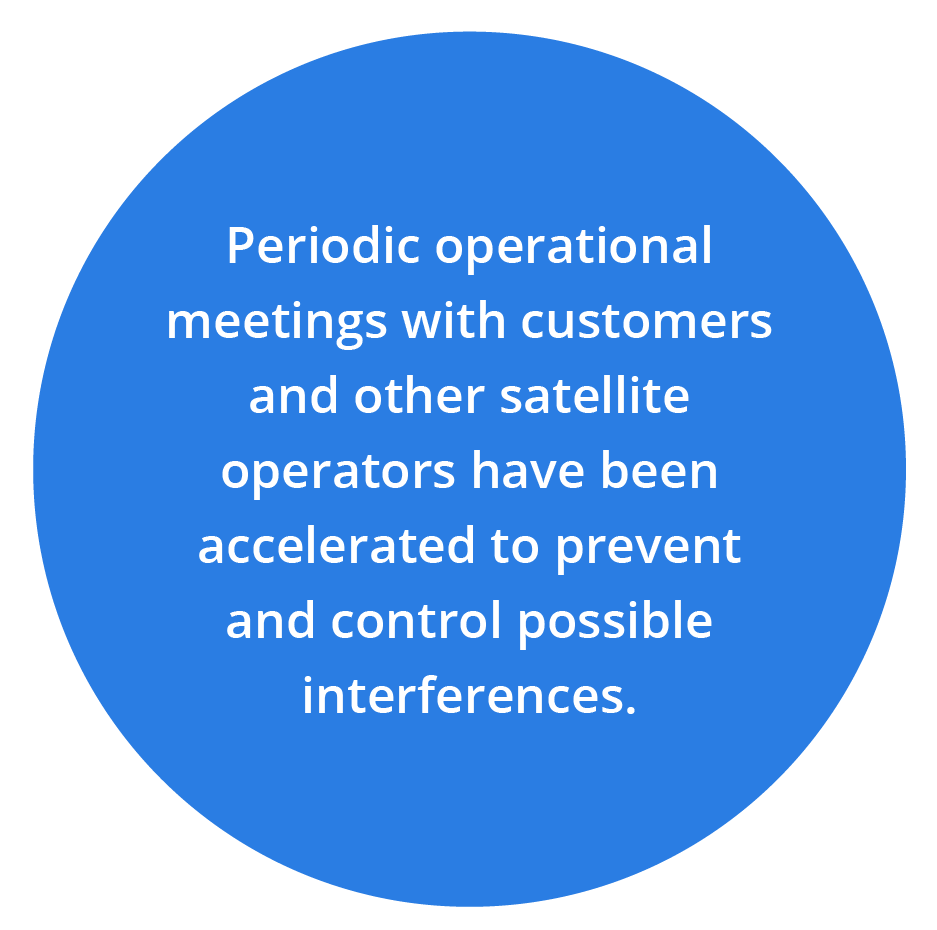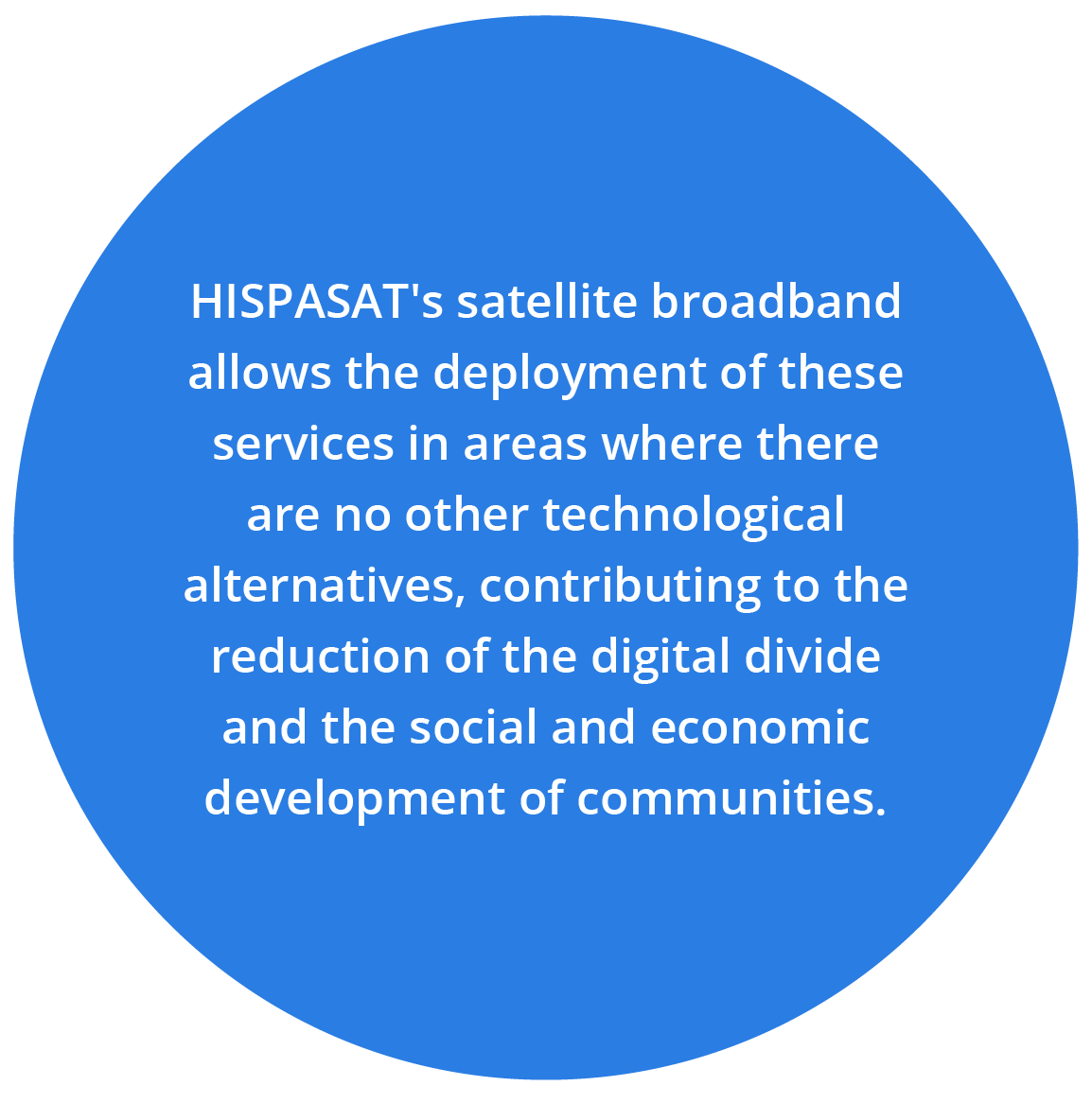SATELLITE FLEET AND CONTROL INFRASTRUCTURE
The 2016 HISPASAT fleet is made up of satellites located at orbital positions 30o West, 36o West, 55.5o West, 61o West, 70o West and 84o West with coverage in Europe, North Africa and America, and a new orbital position 74o West, obtained through a bid in Brazil.
The satellites located at 30o West, Hispasat 30W-4 and Hispasat 30W-5, provide a wide range of communications services for Spain, Portugal and the rest of Europe, as well as for North Africa and America, with capacity on the Ku and Ka bands, o ering full connectivity between Europe and America for voice and data services, audiovisual contents and Internet by means of small-diameter antennas.
Satellites Amazonas 2, 3 and 4, located at 61o West, provide optimal telecommunications services in America, adapted to the speci c communication needs of the region. The o er was expanded because of alliances with other operators, HISPASAT also has special capacity in the H55W-2 (Intelsat 34) and H70W-1 (Star One C$) satellites in order to provide services for new high-demand markets. The Ka band capacity of the Amazonas
3 and Hispasat 30W-5 satellites have been added to the Ku and C band capacity of the satellite eet, which extend the services o er with greater bandwidth and innovative technology.
For ground operation and supervision of the satellite eet, the company has control centres (TTC) for telecommand, telemetry and ranging, which operate 24/7 in Arganda del Rey and Tres Cantos (Madrid), Maspalomas (Gran Canaria) and Flamengo y Guaratiba (Brazil), guaranteeing services of the highest quality and reliability.
In 2016 the company continued the processes of adapting and expanding the terrestrial segment of control for the operation of the new satellites (Hispasat 30W-6, Hispasat 36W- 1 and Amazonas 5 preview for 2017), consisting of new ground stations and equipment for the different locations and operation centres, completing the installation of new stations in Arganda and Maspalomas.
Moreover, construction began on the new control facilities in Serviente (Brazil). Likewise, the new transportable in-orbit test bench is available, which will be used for the in-orbit testing (IOT) campaign for satellites following their launch. Tests are performed before these satellites enter into commercial service in order to ensure that the capacity and services offered are the same as those previously measured on the ground during the construction stage, and the Ku and FSS ground stations used for these types of tests have been recalibrated.

LANDING RIGHTS AND ORBIT-SPECTRUM RESOURCES
HISPASAT has the necessary licenses and/or authorisations (known as landing rights) to operate in all countries for which its satellite system provides coverage, which includes all countries in Western and Central Europe, America and North Africa.
In 2016, progress was made in obtaining the landing rights for the Hispasat 36W-1 satellite, as well as obtaining the same for the Amazonas 5 and Hispasat 30W-6 satellites.
Throughout this year, twenty-nine new authorisations or licenses for the HISPASAT satellite eet were obtained.
In parallel, and in view of the growth of current operators and the emergence of new operators, in 2016 the company intensi ed its analysis of documents published by the International Telecommunications Union (ITU) and its coordination activities with other operators and governments with the aim of maintaining HISPASAT’s orbit spectrum resources.
Likewise, the company has continuously searched for new opportunities for orbit spectrum resources, which may be useful within the framework of the company’s growth strategies.
SPACE CAPACITY OPERATIONS
SATELLITE NETWORK OPERATION CENTRES
The space capacity operation of the satellite eet takes place at the Payload Monitoring Control (PMC) centres, the function of which is as a Network Operations Centre, which manages the space capacity of satellites, 24/7 customer support, carrier line-up/down, signal monitoring, interference detection, peak and pol, and service problem solving.
PMC has operating centres in Arganda del Rey and in Rio de Janeiro, and remote measuring stations (CMS) on di erent frequency bands (C, Ku, Ka) located on the di erent coverage beams in Spain, Argentina, Brazil, Mexico, Colombia, and the United States.
Likewise, they have baseband analysis systems and tools to allocate space and transmission capacity.
PMC has an o ce for occasional use (booking) of space capacity in order to provide these services in the short term, and they also provide support for digital platform broadband services.
PMC OPERATIONS
The increase in the occupation of satellites has led to a signi cant increase in supervision and customer support tasks for all orbital positions. In 2016, operations began at the new 36o West orbital position with the gap ller 36WA satellite and, by means of the strategic agreements signed with Star One, the new 70o West orbital position with the SO C4 satellite (Hispasat 70W-1).

The entry into operation of these new orbital positions has required new monitoring and carrier means, since new antennas pointed at these orbital positions are needed, and has led to a significant increase in PMC tasks due to the migration of active client services from the 84o West orbital position to new positions.
There has also been an increase in occasional transmissions due to the development
of di erent events that require these types of services, such as the elections in Spain, among others.
The agreements reached in the periodic operational meetings with clients, the preventive action of PMC and the correct use of space capacity by clients have made it possible for HISPASAT to continue to o er high-quality services, providing the highest possible value for the majority of their satellites.
In 2016 operations meetings with clients were held for the rst time ever in Río de Janeiro and Mexico City, focusing on coordinating activities, understanding rst-hand the operative issues concerning clients, and making progress in good practices and the use of the system’s space capacity.
With regard to monitoring systems, the expansion of the RF carrier measuring system (CMS) was initiated, with new stations and measuring systems for additional capacity and new satellites to be incorporated in 2016-2017, as well as the operative management system (SIGO) in order to meet business needs in service provision.
Operational relationships with the satellite operators Intelsat and Telesat, which
occupy the orbital positions adjacent to those occupied by the HISPASAT feet, were strengthened with the aim of controlling adjacent satellite interference (ASI), for which operative coordination is essential, since each operator must, in a coordinated fashion, identify the stations of clients that are generating or receiving interference possibly from another satellite outside of their control.


BROADBAND OPERATIONS (BMC)
HISPASAT’s broadband platform is one of the main international suppliers in these types of services based on DVB-RCS and DVB-S2 technology, which facilitate interoperability and their deployment to places where other telecommunications infrastructure does not exist, thereby contributing to the social and economic development of technologically disadvantaged communities and to the reduction of the digital divide. HISPASAT has several platforms offering the most ideal solutions for the corporate, residential and mobility sectors (the latter including vessels, high-speed trains, vehicles and planes).
RESIDENTIAL BROADBAND
With the aim of reducing the digital divide, and through an agreement reached with Euskaltel, HISPASAT continues to provide Internet services via satellite of up to 30 Mbps, both in remote areas lacking connectivity and in areas of limited connectivity, where other means such as fibre optics do not reach. Therefore, a new Ku band hub was deployed which will also o er Ka band services in a multi-spot configuration as soon as it has that capacity with the Hispasat 30W-6 and Hispasat 36W-1 satellites, to be launched in 2017. Additionally, talks with Internet service providers (ISPs) have been resumed in order to o er more competitive services after Plan Avanza finalises.

MOBILITY BROADBAND
HISPASAT, along with Telefónica, turned a pilot project into reality for Renfe’s high-speed train, the AVE, providing Internet services with a bandwidth of up to 40 Mbps per train, combining satellite and 4G technologies. Moreover, thanks to HISPASAT’s technology, the multicast video service is added to this service, providing access to TV channels in the train.
In 2016, HISPASAT continued to o er a solution for Internet on vessels to ISPs for the maritime sector, in wich both, Syntelix and Quantis expanded the services which use HISPASAT’s capacity.
CORPORATE BROADBAND
In 2016, the use of the corporate platform by the manufacturer Gilat in European and Latin American markets was consolidated. In Spain, new projects were developed with small and medium ISPs and with the operator Cellnex.
The migration from the previous hub to the new Gilat hub was completed through a coordinated e ort between operators and end customers. In Latin America new projects with local ISPs were developed and a large part of the service migration to the new Gilat hub took place with satisfactory results.
The di erent activities developed have expanded and improved the company’s portfolio of corporate broadband services in di erent coverage ranges. As an example, there are some clients that specialise in the Internet of Things (IoT), which provide back-up and Scada (telemetry/telecommand) services to security companies in order to strengthen their systems to avoid vulnerabilities in their services and be able to provide them in remote areas lacking connectivity.


